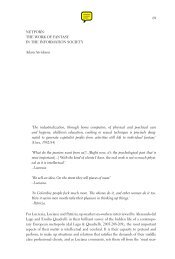Nakamura, Digitizing Race, Introduction, chapter 5, Epilogue
Nakamura, Digitizing Race, Introduction, chapter 5, Epilogue
Nakamura, Digitizing Race, Introduction, chapter 5, Epilogue
You also want an ePaper? Increase the reach of your titles
YUMPU automatically turns print PDFs into web optimized ePapers that Google loves.
46 “Ramadan Is Almoast Here!”<br />
and car modifications—in other words, as ephemeral, often replaced or<br />
swapped-out modules of signification that convey a sense of identity, style,<br />
and community in everyday life, particularly for girls. And like them, the language<br />
of AIM buddies has much to do with popular televisual media, licensed<br />
characters such as Hello Kitty and Powerpuff Girls, and musical trends. Yet<br />
on the other hand, AIM buddies differ from these in that they are part of a<br />
graphical real-time communicative practice that occurs on the computer<br />
desktop, the same space most commonly associated with the Internet and<br />
computing. David Silver’s study of teen girls’ use of the Internet represents<br />
them as a group of users who are more resistant to the commercialization of<br />
the online sphere than had been thought, and notes that the online activities<br />
most popular with girls, e-mail, IM, surfing for fun, and visiting entertainment<br />
Web sites, have more to do with communication than with consumption:<br />
“Female teens approach and use the Internet as a communication tool<br />
rather than as a consumer medium. It appears to us that although American<br />
female teens are eager to use and explore various activities on the Internet,<br />
e-commerce is not one of the major ones.” 11 He also defines IM as a “girl<br />
dominated activity” along with using e-mail and obtaining dieting and<br />
fitness information, and he documents unsuccessful attempts by new media<br />
industries to commodify IM, perhaps as a response to having failed to do so<br />
before it reached its current height of popularity with youth. In any event,<br />
the commercial stakes as well as the theoretical ones for articulating IM<br />
with identities in formation, in particular female and racialized diasporic<br />
and other marginal types of identities, are undeniably high. Herbert Gans’s<br />
writings on the formation of popular culture preferences and practices shed<br />
some light on this issue. Given that the Internet is used with particular intensity<br />
by youth, it makes sense to look to networked new media for representative<br />
examples of diasporic taste cultures. Gans defines popular culture as<br />
the raw material for “taste cultures, because each contains shared or common<br />
aesthetic values and standards of taste. Aesthetic is used broadly, referring<br />
not only to standards of beauty and taste but also to a variety of other<br />
emotional and intellectual values that people express or satisfy when they<br />
choose content from a taste culture.” 12 IM is a communication practice that<br />
possesses a mixed and chaotic taste culture partly because it has resisted<br />
formal modes of commodification until now, and part of its potential lies in<br />
its ability to be repurposed or tweaked in ways that convey identity differently<br />
from received digital networked images.<br />
Identity is a category that has long been perceived as central and important<br />
in cultural studies. Stuart Hall describes the development of the concept





